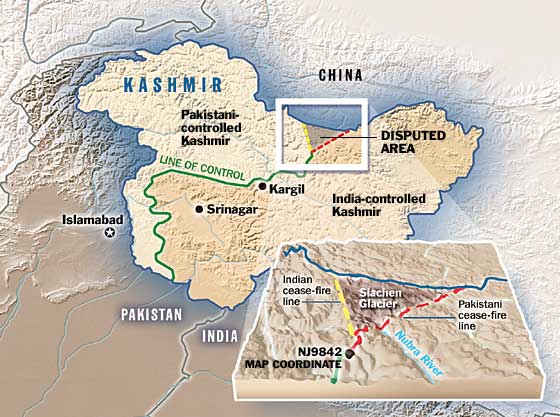I died in pure white snow
Icy hands
Icy toes
Frozen tear decorated my cheeks,
Like crystal clear beads
Always cold
Always alone
Pure White Death by Raven (1)
On April 06, 2012, a serac (large block of ice) wiped out the battalion headquarters of 6th Northern Light Infantry (NLI) at Gayari in Siachin. Instantly, bustling battalion headquarters became the grave of 138 soldiers and civilians attached to 6th NLI; all buried under several feet of snow. Commanding Officer (CO) Lieutenant Colonel Tanvir ul Hassan, Major Zaka-ul-Haq (possibly second-in-command) and Regimental Medical Officer (RMO) Captain Haleemullah Jan were among the casualties. The grave of pure white snow abolished all worldly distinctions of religion, ethnicity, economic and social differences. Officers, Junior Commissioned Officers (JCOs) and soldiers went to eternal sleep along with clerks, barbers, washer men and sweepers. Some were born in the mountains of Gilgit, Hunza, Skardu, Gizar and Astore while others in towns and villages scattered all over the country; Peshawar, Chakwal, Bahawalpur, Nawabshah and Larkana. (2) The collective grave of pure white snow became the final resting place of all these sons of the soil from all over the country. Gayari has now become a hallowed ground for NLI and Pakistan.
Among the soldiers buried under the snow, some had come out without a scratch from the killing fields of Waziristan to find their final resting place in the snowy mountains of Siachin. We will never know what the last thoughts of these brave men were. May be someone was holding in his hand the letter from his mother or wife or clutching to the picture of his smiling son or daughter. May be a silent prayer or flashback of memories of their loved ones before the spark of life left the mortal bodies.
In 1984, India sent its soldiers to the God forsaken mass of ice and snow of Siachin making it the highest altitude battlefield. Battlefield is probably a misnomer. In the last three decades, both sides have fired very little weapons at each other, but lost countless men to harsh weather and terrain that tests limits of human endurance. In the last three decades, both India and Pakistan have spent billions of rupees to maintain their respective small garrisons. Terrain rather than adversary’s bullets have taken a heavy toll with thousands dead and disabled from frost bites and snow blindness. Pakistan has deployed three battalions and India seven battalions on Siachin. According to one report, India spends Rs. 30 billion and Pakistan Rs. 5.4 billion every year to maintain their respective garrisons. Pakistan looses about one hundred while India one hundred and eighty soldiers every year to the forbidding terrain. (3) What is the real meaning of this exercise? A small piece of heart is ripped off from an Indian or Pakistani mother every day. Their sobs are drowned in the noise of patriotism and their tears are covered by the national flags but that does not diminish the pain.
Siachin has become a haunted place for both countries and souls of brave soldiers whose bodies were never recovered now roam that land. We hope that the collective sacrifice of these 138 soldiers and countless others ignite the spark of humanity on both sides. May the courageous among the both nations see the absurdity of this exercise and work towards demilitarization of Siachin. The death toll of eight thousand Indian and Pakistani soldiers so far claimed by the forbidding terrain is way too much. Hopefully, many more lives of young and brave soldiers of both countries can be saved. This will be the true tribute to the sacrifice of the soldiers of their respective countries. We hope that sooner rather than later, Siachin is demilitarized and a monument commemorating the sacrifices of soldiers of India and Pakistan is erected.
“The young dead soldiers do not speak.
Nevertheless, they are heard in the still houses:
who has not heard them?
They have a silence that speaks for them at night
and when the clock counts.
They say: We were young. We have died.
Remember us.
They say: We have done what we could
but until it is finished it is not done.
They say: We have given our lives but until it is finished
no one can know what our lives gave.
They say: Our deaths are not ours: they are yours;
they will mean what you make them.
They say: Whether our lives and our deaths were for
peace and a new hope or for nothing we cannot say,
it is you who must say this.
We leave you our deaths. Give them their meaning.
We were young, they say. We have died; remember us.”
‘ The Young Dead Soldiers Do Not Speak’ by Archibald MacLeish
Notes:
1- Pure White, Snow Poem
http://www.familyfriendpoems.com/poe...#ixzz1rY9lsG7M
www.FamilyFriendPoems.com
2-
http://www.ispr.gov.pk/front/main.as...17#wv_link2017
3-
http://www.thenews.com.pk/Todays-New...led-in-Siachen









Bookmarks